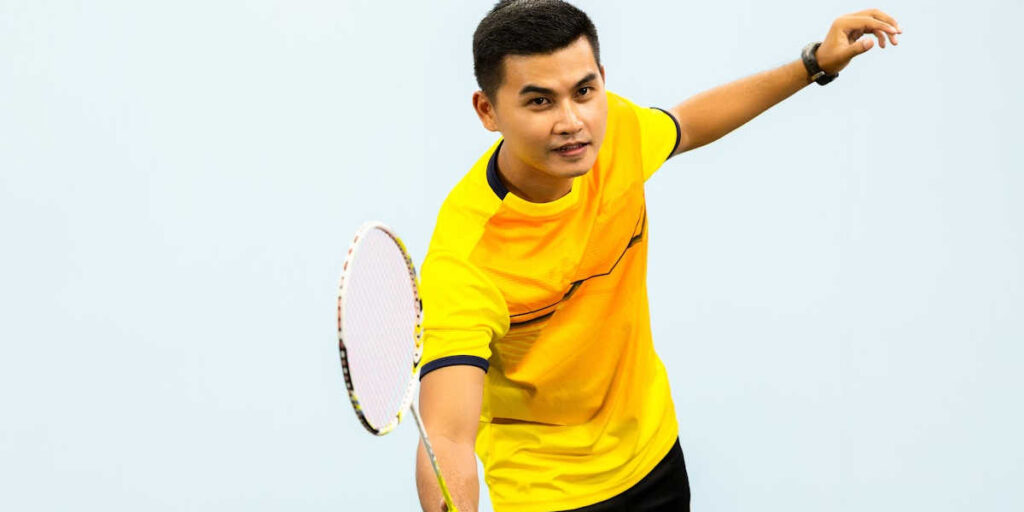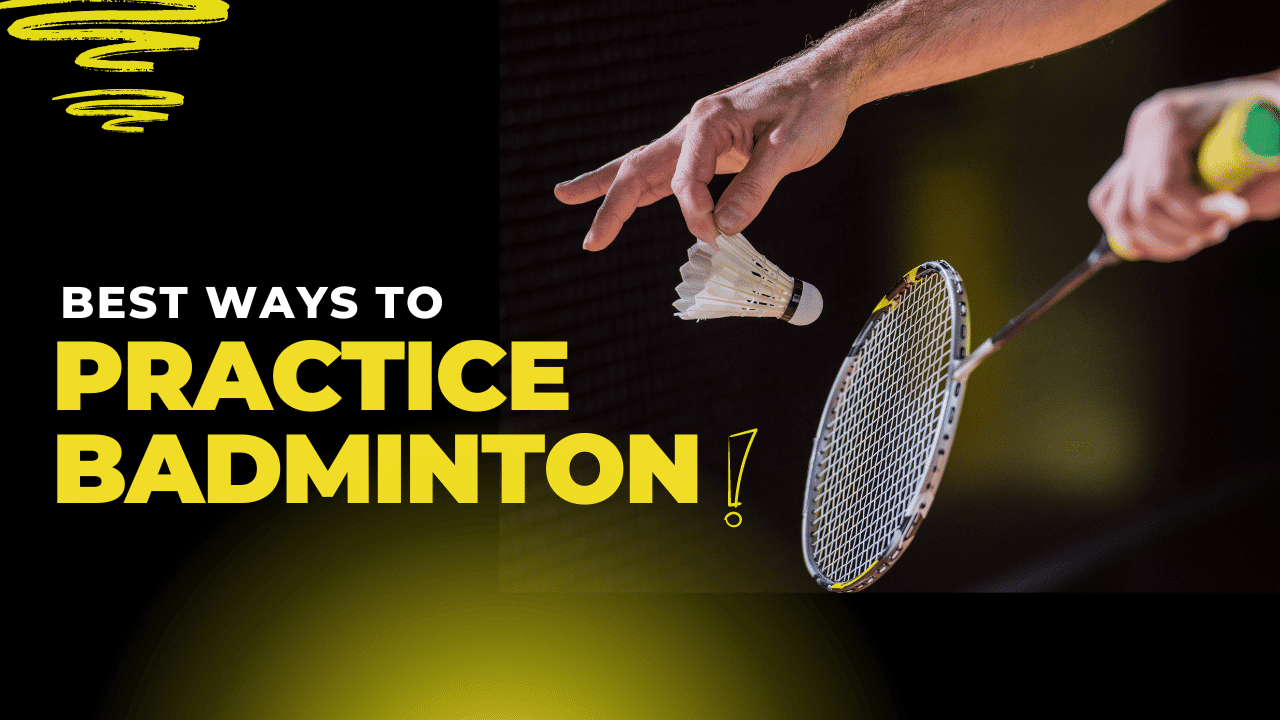Badminton requires a lot of practice, and there are three best ways to practice badminton.
- Practice badminton on your own
- Practice badminton with a partner
- Practice badminton by observing other matches
Each way of practice has several exercises and drills that you can use. I am going to discuss all those in this article.

Which is the Best Way to Practice Badminton?
If you want me to choose one of the three above-mentioned ways of playing badminton, then that’s not going to happen. Because to truly improve, you need to do them all.
- You need to master the basics and fine-tune your skills by playing on your own.
- You need to learn to analyze your opponent’s gameplay, anticipate their moves, and build a winning strategy, all while being on the court. This is only possible if you practice with a partner.
- Watching professional players or even players at your own level gives you insight into how different playing styles could be. You get ideas to adopt one of them or tweak one to suit your style. That’s why you need to practice badminton by observing other matches
Now that this is out of the way, let’s discuss how to practice badminton using each of these ways.
Practice Badminton on Your Own
The best way to get your basics under control is by practicing badminton on your own. Here are the best techniques to follow on your own.
Shadow Badminton
Shadow badminton involves practicing your strokes and footwork without a shuttlecock. You mimic the movements and actions you would perform during a match.
Benefits:
- Improves footwork and movement patterns.
- Helps in mastering stroke techniques.
- Enhances muscle memory for different shots.
How to Practice:
- Stand in the middle of the court and hit forehand and backhand shots to different corners.
- Mimic the movements of a rally by moving back and forth across the court.
- Use cones or markers to represent different positions on the court. Move between these positions while performing shadow strokes.
Wall Rallies
Wall rallies involve hitting the shuttlecock against a wall to simulate a rally. The wall acts as an opponent who is returning the shuttle back to you.
Benefits:
- Improves timing, accuracy, and consistency.
- Develops quick reflexes and reaction time.
- Allows you to practice a variety of shots.
How to Practice:
- Stand a few feet away from the wall and hit the shuttlecock against it. Try to maintain a continuous rally by hitting the shuttle back as it rebounds off the wall.
- Mark specific spots on the wall and aim your shuttlecock at it.
Footwork Drills
Good footwork is essential for reaching the shuttle quickly and efficiently. That’s why these specific drills are focused on improving your movement and positioning on the court.
Benefits:
- Enhances agility and speed.
- Improves balance and coordination.
- Helps in maintaining proper stance and positioning during play.
How to Practice:
- Set up cones or markers on the court and practice side-to-side movements. Focus on staying low and moving quickly between points.
- Practice moving quickly from the baseline to the net and back.
- Practice jumping for smashes and lunging for net shots. Focus on landing softly and recovering quickly to the ready position.
Multi-Shuttle Drills
Multi-shuttle drills involve using multiple shuttles to practice specific shots repetitively. This drill requires preparation but is highly effective for building consistency.
Benefits:
- Builds endurance and stamina.
- Improves shot accuracy and precision.
- Allows focused practice on specific shots.
How to Practice:
- Throw one shuttlecock up and hit a second one from the ground before catching the first one.
- Place multiple shuttlecocks on the floor in a sequence and practice hitting them in a specific order.
- Set a timer and see how many shuttles you can hit within a certain period.
Practice Badminton with a Partner
Practicing with a partner is as important as practicing alone. You learn to anticipate shots and get real-game stimulation. Here are some ways you can practice with your partner.
Drive and block drill
The drive and block drill involves two players hitting fast, flat drives to each other. One player hits aggressive drives, while the other focuses on blocking and returning them.
Benefits:
- Enhances reflexes and reaction time.
- Improves precision and control in fast-paced exchanges.
- Develops defensive skills and the ability to counterattack.
How to Practice:
Both players stand on opposite sides of the net, close to the mid-court area. Player A starts by hitting a fast, flat drive to Player B. Player B blocks and returns the shot with another drive. Continue this exchange, focusing on maintaining speed and accuracy. Switch roles after a specific time period.
Net kill practice
The net kill practice focuses on improving your net play by practicing aggressive net kills. One player feeds shuttles near the net. The other executes precise and quick net kills.
Benefits:
- Improves hand-eye coordination and reaction time.
- Develops precision and control in net shots.
- Enhances the ability to finish points at the net.
How to Practice:
Player A stands near the net with a shuttle feeder, and Player B stands on the opposite court. Player A gently tosses or hits shuttles just above the net height. Player B practices hitting net kills.
Conditioning Games
Conditioning games are designed to combine physical conditioning with skill practice. These games simulate match conditions and help improve fitness, agility, and tactical awareness.
Benefits:
- Builds endurance and stamina.
- Enhances agility and on-court movement.
- Promotes competitive spirit and tactical thinking.
How to Practice:
- Play rallies to 10 points, but with a specific focus on a particular shot type.
- Play for set durations of time and try to maintain stamina and consistency throughout that time.
- Mark specific zones on the court and award points for landing shots in those zones.
Practice Badminton by Observing Other Matches
It would be great if there were computer programs to analyze the playing patterns and styles of professional badminton players. Fortunately for us, the technology is very well developed.
With apps like Hudl Technique, Coach’s Eye, Technique, and Dartfish Express, you can record and analyze match patterns, view videos in slow motion, play two videos side-by-side, and more. All of this is useful to analyze playing patterns.
You can even use these apps to record yourself and understand where you are going wrong. Gives a lot of room for improvement. Keeping this apart, let’s focus on how you can practice badminton by observing others’ matches.
- Break Down the Game
Pay close attention to footwork, shot selection, and strategic positioning. Analyze how they handle pressure situations and adapt their game throughout the match.
- Identify Key Techniques
Isolate specific techniques used by the pros, like deceptive strokes or powerful smashes. Deconstruct these techniques and try to understand the mechanics behind them.
- Apply to Your Game
Gradually incorporate these learnings into your own practice sessions. Start by mimicking footwork patterns or practicing specific shots used by the pros.
Conclusion
Practicing badminton effectively involves a combination of structured routines, physical conditioning, mental preparation, and using technology. You can develop your skills and improve your overall game by doing solo, partner, and group drills.
Remember, effective badminton practice requires dedication, consistency, and a love for the game. Without these, it is difficult to succeed. So, enjoy the process, stay committed, and most importantly, have fun on the court!
FAQs
How can I increase my stamina for badminton?
You can increase your stamina for badminton by using a two-pronged approach. This involves cardiovascular training and interval training. The cardiovascular training will help your heart and lungs prepare for intense movements around the court. The interval training will improve your endurance on the court.
How to go pro in badminton?
To become a badminton pro, you need to train regularly. It’s best if you start training from a young age. Seek professional coaching from a private coach or take admission to a sports academy. Build your body’s strength to sustain the pressure of the matches. Regularly participate in games and tournaments. Start with local matches and move your way up to the professional level.
How do you get in shape for badminton?
The only way to get in shape for badminton is by following a regular exercise routine. Your routine must include cardio, High-Intensity Interval Training (HIIT), and badminton-specific drills.
How do I improve my badminton skills?
To improve your badminton skills, you first need to master the basics. Once you get a hold of all the grips and techniques, you will see improvement in yourself. Later, you must learn to strategize and use deceptive play to improve your game further.
How do I practice badminton by myself?
I have discussed several ways in this article to practice badminton by yourself. Use them wisely and become a better badminton player.
